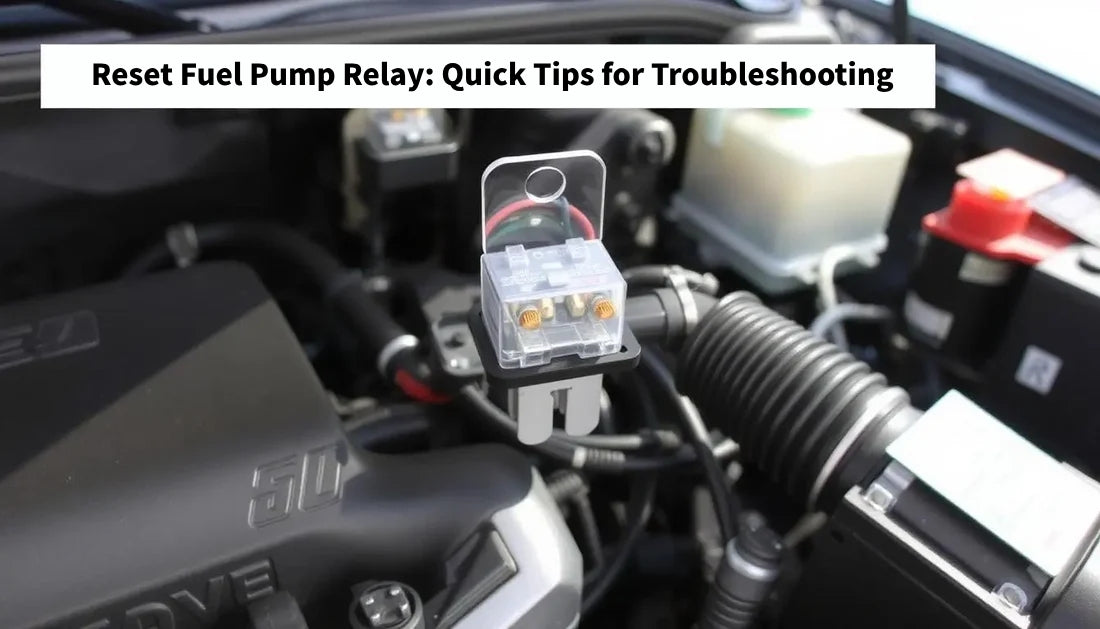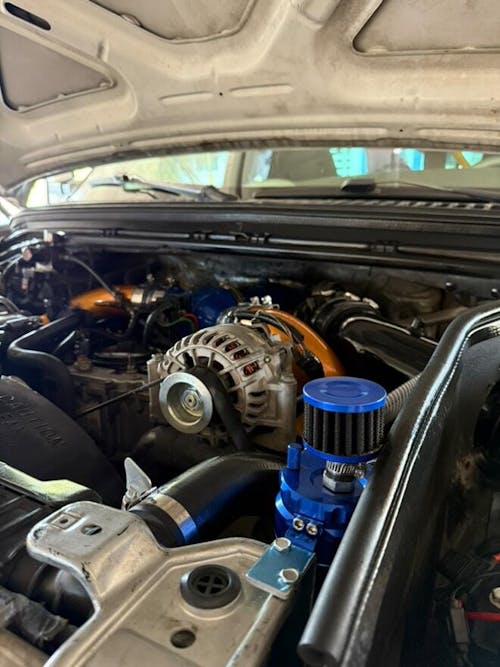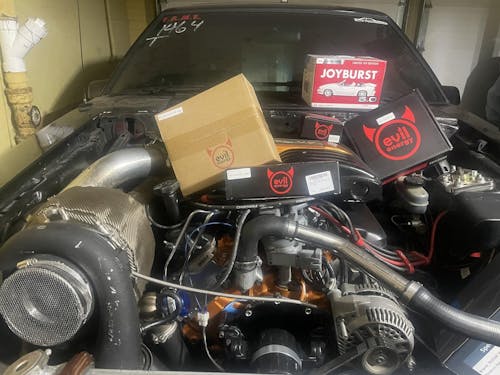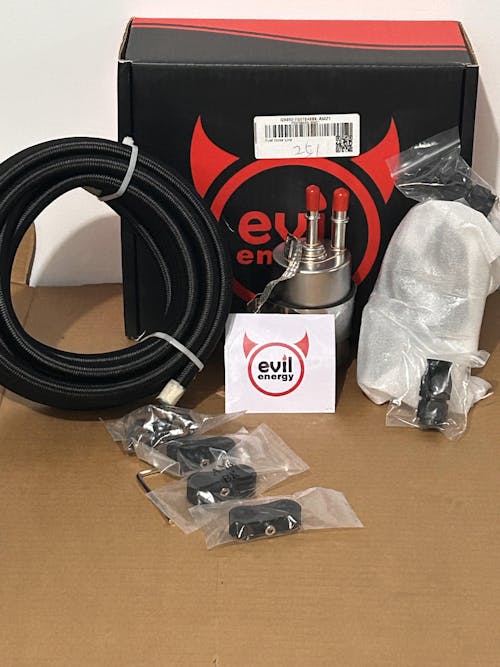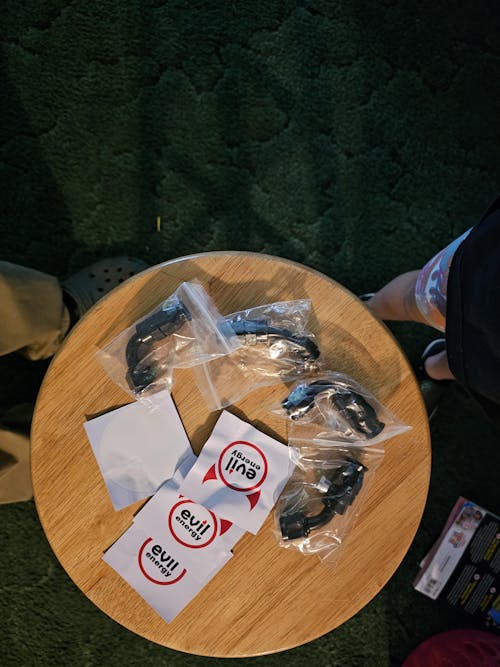Reset Fuel Pump Relay: Quick Tips for Troubleshooting
A faulty fuel pump relay can really mess up your car's fuel system. This part is key for powering the fuel pump. If it fails, you might find yourself stuck. Knowing how to reset it can save you a lot of hassle and money.
This article will cover the basics of the fuel pump relay system. We'll also show you how to reset it step by step. Whether you're new to car maintenance or have some experience, this guide will help you fix fuel pump relay issues and keep your car running right.
Introduction to Fuel Pump Relay Troubleshooting
The fuel pump relay is a vital part of your car's fuel system. Knowing how it works is key for fixing problems. By learning to reset it, you can avoid expensive repairs and get back on the road fast.
Understanding Your Car's Fuel Pump Relay System
The fuel pump relay system is key to your car's operation. Knowing its parts and how it works is vital for fixing and keeping it running well. The relay is usually in the fuse box or relay box. It handles the fuel pump's high current, protecting other parts from damage.
The relay acts as an electromagnetic switch. It turns on the fuel pump when you start the ignition. This switch is made to handle the fuel pump's high current. It keeps other electrical parts safe.
To grasp the fuel pump relay system, it's important to know its main parts. These include the relay, the fuel pump, and the wiring harness.
- Relay: The electromagnetic switch that activates the fuel pump
- Fuel Pump: The component responsible for pumping fuel to the engine
- Wiring Harness: The network of wires that connects the relay to the fuel pump and other electrical components
Knowing where the fuel pump relay is and how it works helps you fix your car's fuel system problems. Regular checks and maintenance of the fuel pump relay system can prevent issues. This ensures your car runs smoothly.
Signs of a Faulty Fuel Pump Relay
A faulty fuel pump relay can cause many problems with your car's fuel system. It's important to know the signs of a bad relay to avoid bigger issues. Common signs include trouble starting the car, stalling, or a complete fuel system failure.
If the relay doesn't turn on the fuel pump, your engine won't get the fuel it needs. This leads to fuel pump relay problems.
Other signs might include a clicking sound from the relay when you turn the key. Or, the fuel pump might not turn on at all. These symptoms of faulty relay can be really frustrating and might leave you stuck.
It's key to fix these problems quickly to avoid harming your car's engine.
Some common issues with a bad fuel pump relay include:
- Difficulty starting the engine
- Stalling or sputtering
- Loss of power while driving
- Clicking or whirring sounds from the relay
By spotting these signs and fixing the problem fast, you can stop bigger issues. If you're seeing any of these symptoms, it's vital to find out why and fix it. This will help keep your vehicle running well.
Essential Tools for Fuel Pump Relay Work
Working on your vehicle's fuel pump relay needs the right tools for a good repair. You'll need basic hand tools, diagnostic equipment, and safety gear. This ensures your safety and the quality of the repair. We'll cover the tools you need, including those for replacing the relay and for diagnostics.
You'll start with basic hand tools like screwdrivers, pliers, and wrenches. These help you find and remove the relay. A multimeter is also key for spotting electrical problems that might affect the relay.
Basic Hand Tools Required
- Screwdrivers (flathead and Phillips)
- Pliers (needle-nose and slip-joint)
- Wrenches (adjustable and fixed)
Diagnostic Equipment Options
Diagnostic tools are vital for finding electrical issues in your fuel pump relay system. A multimeter lets you check voltage, current, and resistance. This helps you spot problems with the relay or wiring.
Safety Equipment Checklist
Always prioritize safety when working with electrical systems. Wear gloves and safety glasses to avoid injuries from electrical shocks or debris. With the right tools and equipment, you're ready to replace the fuel pump relay safely and effectively.
Locating Your Vehicle's Fuel Pump Relay
To find the fuel pump relay in your vehicle, check the repair manual or look for labels on the fuse box. The relay is often in the fuse box or a separate box, usually under the hood or inside the car. Finding the right relay can be tricky, but with the right help, you can avoid more electrical problems.
Where you find the fuel pump relay depends on your vehicle's make and model. Some common spots include:
- Under the hood, in the fuse box or relay box
- Inside the car, on the driver's side or passenger's side
- On the steering column or near the ignition switch
Finding the right relay is key to avoid electrical issues. Knowing where the fuel pump relay is helps you fix problems with your vehicle's fuel pump system.
Looking at diagrams or labels on the fuse box can also help you find the fuel pump relay. By taking the time to find the correct relay location, you ensure you're accessing the right information safely.
Safety Precautions Before You Begin
Working with electrical systems in your car requires safety precautions to avoid injuries and damage. Make sure the car is in park and the parking brake is on before starting. This step is crucial for your safety while handling electrical components.
Disconnect the battery to prevent short circuits before you begin. Wearing gloves and safety glasses can also prevent accidents. Also, ensure the work area has good ventilation to avoid flammable gases.
- Always disconnect the battery before starting work
- Wear protective gear, such as gloves and safety glasses
- Ensure good ventilation in the work area
- Follow proper safety precautions when working with electrical components
By following these steps and taking the right safety precautions, you can have a safe and successful experience with your car's electrical systems.
How to Reset Fuel Pump Relay: Step-by-Step Guide
Resetting the fuel pump relay is easy and can be done in a few steps. It's key to follow a step-by-step guide to avoid harming your vehicle's electrical system. Resetting the fuel pump relay needs careful actions and attention to detail.
First, make sure your vehicle is ready by disconnecting the battery. This step prevents accidental starts or electrical shocks. Then, find the fuel pump relay, often in the fuse box or relay panel.

- Disconnect the battery to prevent any accidental starts or electrical shocks.
- Locate the fuel pump relay and remove it from its socket.
- Check the relay for any signs of damage or wear.
- Replace the relay if necessary, or proceed with the reset procedure.
By following these steps and being careful, you can reset the fuel pump relay successfully. Always use a step-by-step guide when working with electrical systems. This keeps you safe and your vehicle in good shape.
Testing the Relay After Reset
To make sure the fuel pump relay works right after resetting, you need to do a relay function test. Listen for the fuel pump to start when you turn the ignition on. If it's working, the pump should turn on, and your car should start up fine.
Another way to test the fuel pump relay is with a multimeter. Check for voltage at the fuel pump. This shows if the relay is sending the right signal to the pump. These tests help confirm if the relay test was a success and the pump is working right.
Here's how to test the fuel pump relay:

- Turn the ignition on and listen for the fuel pump to activate
- Use a multimeter to check for voltage at the fuel pump
- Verify that the fuel pump is working correctly and the vehicle starts normally
By following these steps and doing a detailed relay function test, you can make sure the fuel pump relay is working right. This ensures your vehicle runs smoothly.
Common Problems During Reset Procedures
When trying to reset the fuel pump relay, knowing common problems is key. These can be electrical issues or mechanical complications. It's important to fix these quickly to avoid more damage to your vehicle.
Common reset problems include electrical shorts, blown fuses, and fuel pump mechanical issues. Finding and fixing the main problem is crucial to avoid more damage.
Troubleshooting Electrical Issues
- Check for loose connections or corrosion on the electrical terminals
- Verify that the fuse has not blown due to an electrical surge
- Inspect the wiring for any signs of damage or wear
Addressing Mechanical Complications
Sometimes, mechanical complications can happen during the reset. This might include problems with the fuel pump's motor or other parts. If you're not sure how to fix these, it's best to get a professional mechanic's help.
Knowing about these common problems and acting fast can help you reset the fuel pump relay successfully. This will get your vehicle running smoothly again.
Maintaining Your Fuel Pump Relay System
Regular fuel pump relay maintenance is key to avoiding fuel system problems. Simple upkeep tasks can help your fuel pump relay system last longer and work better. This includes keeping the electrical system in check, avoiding extreme temperatures, and keeping the fuel system clean.
For system upkeep, check the relay and its connections often. This helps spot problems early. Also, use top-quality parts and follow the maker's maintenance advice to avoid wear and tear.

- Regularly check the fuel pump relay and its connections for wear or damage
- Keep the vehicle's electrical system in good shape to avoid power surges or spikes
- Avoid extreme temperatures, which can harm the fuel pump relay system's performance and lifespan
By following these tips and doing regular fuel pump relay maintenance, you can avoid fuel system problems. This ensures your vehicle runs well and efficiently. Remember, regular system upkeep is crucial for a long-lasting fuel pump relay system and to avoid expensive repairs later.
Preventive Measures to Avoid Future Issues
To avoid future issues with the fuel pump relay, it's key to take preventive measures. Having a regular maintenance schedule helps spot and fix problems early. This means checking the fuel pump relay and its parts for wear or damage.
Regular upkeep can stop issues like lower fuel efficiency, hard engine starts, or odd fuel pump noises. By watching for these signs, you can act fast to stop bigger problems.
- Regularly checking the fuel pump relay and its components for signs of wear or damage
- Monitoring fuel efficiency and engine performance
- Checking for unusual noises or vibrations from the fuel pump
By sticking to thesepreventive measuresand keeping up with a regularmaintenance schedule, you can make sure your fuel pump relay system lasts longer and works better.
When to Replace Instead of Reset
Replacing the fuel pump relay might be better than just resetting it. This choice depends on the relay's condition and the problem's nature. Age-related factors are key, as older relays can fail more easily due to wear and corrosion.
It's important to check how damaged the relay is after a failure. If it's been damaged by a short circuit or overheating, resetting it might not fix it. In such cases, replacing fuel pump relay is safer and more effective.
Here are some guidelines for deciding between replacing and resetting:
- Look for physical damage or corrosion on the relay.
- Check the relay's electrical contacts for wear or burn marks.
- Consider the relay's age and its expected lifespan.
By thinking about these points and being proactive with maintenance, you can keep your vehicle's fuel pump relay system working well.
Conclusion
Fixing and resetting the fuel pump relay is easy with the right info and tools. Knowing how the system works, spotting a bad relay, and learning how to fix or replace it helps a lot. This way, you save time and money, and your car's fuel system works well.
Keeping up with maintenance and watching your fuel pump relay closely helps avoid big repair bills. Look out for warning signs, stick to a maintenance plan, and get help if you run into tough electrical or mechanical problems. With these tips, you'll keep your car running great.
FAQ
What is a fuel pump relay?
A fuel pump relay is an electromagnetic switch. It turns on the fuel pump when you start the car. It also protects other electrical parts from damage by handling high current.
How does the fuel pump relay function in a vehicle?
The fuel pump relay powers the fuel pump. When you turn on the ignition, it closes the circuit. This lets electricity flow to the fuel pump, starting it.
What are the common components of the fuel pump relay system?
The fuel pump relay system includes the relay, fuel pump, wiring, and the car's electrical system.
What are the signs of a faulty fuel pump relay?
Signs of a bad fuel pump relay include hard starts, engine stalling, and a clicking sound. The fuel pump might not turn on at all.
What tools are needed for fuel pump relay work?
You'll need basic tools like screwdrivers, pliers, and wrenches. A multimeter is also useful for finding electrical problems.
How do I locate the fuel pump relay in my vehicle?
The fuel pump relay is usually in the fuse box or a relay box. Look under the hood or inside the car. The repair manual or fuse box labels can help you find it.
What safety precautions should I take when working with the fuel pump relay?
Always disconnect the battery first to avoid short circuits. Make sure the car is in park and the parking brake is on. Wear protective gear and work in a well-ventilated area.
How do I reset the fuel pump relay?
To reset the relay, power down the vehicle. Find and remove the relay. Then, replace a fuse or reinstall the relay after a short time.
How do I test the fuel pump relay after resetting it?
Test the relay by listening for the fuel pump when you turn on the ignition. Or, use a multimeter to check for voltage at the fuel pump.
What common problems may arise during the fuel pump relay reset process?
Common issues include electrical shorts, blown fuses, or fuel pump mechanical problems. If problems continue, get professional help.
How can I maintain my fuel pump relay system to prevent future issues?
Keep the electrical system in good shape. Avoid extreme temperatures and ensure a clean fuel system. This helps prevent relay problems.
When should I replace the fuel pump relay instead of resetting it?
Replace the relay if it's old, corroded, or damaged. This is better than trying to reset a worn-out relay.


![EVIL ENERGY 4/6/8/10AN PTFE Fuel Line Kit | E85 Nylon Braided Hose | 16/20FT Black Black with Comprehensive Fittings [20FT]](http://www.ievilenergy.com/cdn/shop/files/Test-2025-Evilenergy-125598065_165x.png?v=1742144807)
![ptfe hose fitting kit [16FT]](http://www.ievilenergy.com/cdn/shop/files/Test-2025-Evilenergy-125598171_165x.png?v=1742144807)
![CPE Fuel Line[25FT]](http://www.ievilenergy.com/cdn/shop/files/25FTCPE_FuelLine_165x.png?v=1735220649)
![CPE Fuel Line[20FT]](http://www.ievilenergy.com/cdn/shop/files/20FTCPE_FuelLine_165x.png?v=1735220649)
